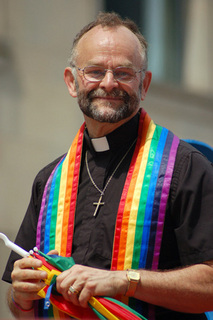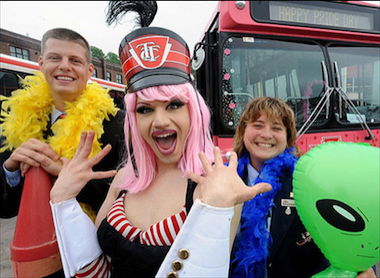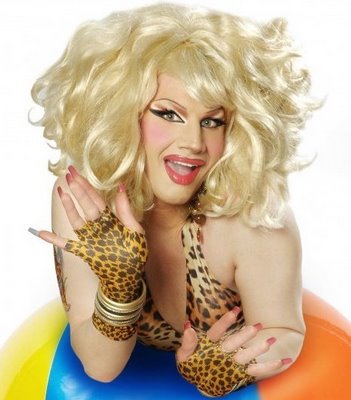|
presents THIS DAY IN GAY HISTORY based on: The White Crane Institute's 'Gay Wisdom', Gay Birthdays, Gay For Today, Famous GLBT, glbt-Gay Encylopedia, Today in Gay History, Wikipedia, and more …
Collected by Ted June 29 [{(o)}]|[{(o)}]|[{(o)}]|[{(o)}]| [{(o)}]|[{(o)}]
1585 (or 1592) – Catalina de Erauso (in Spanish; or Katalina Erauso in Basque) who went by Alonso Díaz, Antonio de Erauso, and some other masculine names and is also known in Spanish as La Monja Alférez (English, The Ensign Nun), was a one-time nun who subsequently travelled around Spain and Spanish America, mostly under male identities, in the first half of the 17th century. Erauso's story has remained alive through historical studies, biographical stories, novels, movies and comics. Erauso's parents were Miguel de Erauso and Maria Pérez de Arce Gallarraga. Miguel was a captain and military commander of the Basque province under the orders of King Philip III of Spain. From an early age, Erauso trained with him and her brothers in the arts of warfare. Around the year 1589, at age 4, Erauso was taken to the Dominican convent of San Sebastian el Antiguo, where Erauso's mother's cousin was prioress. Erauso grew into a strong, stocky, and quick-tempered individual. Lacking religious vocation and refusing to take vows, Erauso was detained in a cell. At 15, after being beaten by one of the nuns, Erauso decided to escape. On March 18, 1600, the eve of San Jose, Erauso found the keys of the convent hanging in a corner, waited for the nuns to be at morning prayer, and escaped. Erauso spent a week fashioning boy's clothes, and headed for Vitoria, staying off the main roads. With short hair, Erauso easily passed as a boy there. From this moment on, Erauso began the life of a fugitive, later narrated in the autobiography that gave her great fame. In Vitoria, Erauso met a doctor and professor, Francisco de Cerralta. Erauso stayed with him for three months, learning some Latin, but when Cerralta became abusive, Erauso left. Erauso took money from the doctor, met a mule driver and went with him to Valladolid where the court of King Philip III of Spain resided, under the influence of the Duke of Lerma. Disguised as a man by the name of Francisco de Loyola, Erauso served in the court for seven months as a page of the king's secretary, Juan de Idiáquez, until one day Erauso's father came to speak with Idiáquez, asking for information about his missing child, describing her physical appearance and the way she escaped from the convent, all without recognizing that he had just spoken with her. Afterwards, Erauso decided to head to Bilbao. Upon arriving, Erauso could not find a place to sleep or a patron. In addition, a group of boys attacked her, and when she got into a rock fight and injured one, she was arrested and spent a month in jail. Once released from prison, Erauso went to Estella, and found work as a page there too, under an important lord of the town called Alonso de Arellano. Erauso was his servant for two years, always well treated and well dressed. Between 1602 and 1603, after years of service to Arellano, Erauso returned to San Sebastián, her hometown, and lived as a man there, taking care of relatives, whom she saw frequently. She also attended mass in her old convent with former colleagues. It is said that she also served her aunt without ever being recognized. After some time, she came to Pasaia, where she met Captain Miguel de Berróiz, who took her to Seville. She later returned to Sanlucar de Barrameda, where she found a job as a cabin boy on a ship. Captain Esteban Eguiño, who was a cousin of her mother, owned the galleon. According to memoirs, she embarked on Holy Monday, 1603 to America. Erauso felt, like many Basques of her time, inclined to venture to the Indies. She spent this time dressed as a man, with short hair, using different names such as Pedro de Orive, Francisco de Loyola, Alonso Díaz [Ramirez] de Guzmán, and Antonio de Erauso. Apparently her physique was not feminine, which helped her pass as a man. Erauso once said she "dried her breasts" with a secret ointment. The first place in the Americas where Erauso landed was Punta de Araya, now part of Venezuela. From there she went to Panama, where she spent three months. In Panama she started working with Juan de Urquiza, a merchant with whom she went to the port of Paita (now Peru), where the trader had a large shipment. In the port of Manta (now Ecuador), a strong wind destroyed the ship and Erauso had to swim to save herself and her master. The rest of the crew perished. After a brief time back in Paita, she went to Zana. There, her grateful master happily gave Erauso a home, clothing and a large amount of money, as well as three black slaves. In Saña she had a fight with a young man who threatened her. She ended up cutting up the face of the young man. She was taken to jail again and through efforts of her master Juan de Urquiza, and the bishop of that place, she was released on the condition that she married Doña Beatriz de Cárdenas, lady of her master and aunt of the man whose his face she had cut. Not wanting to be discovered, she refused to marry. Instead she went to the city of Trujillo, where her master had opened a store. However, the man who was wounded came to challenge her again accompanied by two friends. Erauso went into the fight with another person, and in the fight the man's friend was killed. She was again imprisoned, but her master saved her again. He gave her money and a letter of recommendation and sent her to Lima, which was the capital of the Viceroyalty of Peru. She gave the letter of recommendation to Diego de Solarte, a very rich merchant and consul of Lima, and after a few days she was given management of his shop. She was responsible for the business for nine months, but was fired when discovered fondling a woman, the sister of her master's wife. After being dismissed, she found a company recruiting, whose aim was the conquest of Chile and, beset by the need to find a new occupation, she enlisted under the command of Captain Gonzalo Rodriguez. She was accompanied by 1600 men from Lima to the city of Concepción. From 1617-19 she worked as a llama-driver from Chuquisaca to the great mining center of Potosí, and was then recruited as a soldier. After marching with her company to Chile in 1619, her army swept through the lands and property of the Mapuches, showing her aggressive side as conqueror, massacring many Indians. In Chile she was welcomed by the secretary of the governor, who was her brother, Don Miguel de Erauso, but did not recognize her. She remained there for three years and because of a dispute with her brother, possibly because of another woman, was banished to Paicabí, the land of Indians. There, Erauso fought in the service of the crown in the Arauco War against the Mapuches in today's Chile, earning a reputation for being brave and skillful with weapons and without revealing that she was a woman. In 1623 Erauso was arrested in Huamanga, Peru, because of a dispute. To avoid execution, she begged for mercy to Bishop Agustín de Carvajal, and confessed that she was a woman who had been in a convent. Following a review in which a group of matrons determined that Erauso was a woman and a virgin, the bishop protected her and she was sent to Spain. In 1626,Pope Urban the Eighth gave Catalina de Erauso the right to live as a man named Francisco de Loyola. In 1630 Erauso settled in the New Spain, probably in the city of Orizaba, now in the state of Veracruz, and established a business as a muleteer between Mexico City and Veracruz. Locals state that Erauso died carrying a load onto a boat.
1892 – Henry Gerber (d.1972) was an early homosexual-rights activist in the United States. Inspired by the work of Germany's Magnus Hirschfeld and his Scientific-Humanitarian Committee, Gerber founded the Society for Human Rights (SHR) in 1924, America's first known homosexual organization, and Friendship and Freedom, the first known American homosexual publication. SHR was short-lived, as police arrested several of its members shortly after it incorporated. Although embittered by his experiences, Gerber maintained contacts within the fledgling homophile movement of the 1950s and continued to agitate for the rights of homosexuals. Gerber has been repeatedly recognized for his contributions to the LGBT movement. Gerber was born Joseph Henry Dittmar (some sources say "Josef") in Passau, Bavaria. He changed his name to "Henry Gerber" upon emigrating to the United States in 1913. He and others in his family settled in Chicago because of its large German immigrant population. In 1917, Gerber was briefly committed to a mental institution because of his homosexuality. When the United States declared war on Germany, Gerber was given a choice: be interned as an enemy alien or enlist in the Army. Gerber chose the Army and he was assigned to work as a printer and proofreader with the Allied Army of Occupation in Coblenz. He served for around three years. During his time in Germany, Gerber learned about Magnus Hirschfeld and the work he and his Scientific-Humanitarian Committee were doing to reform anti-homosexual German law, especially Paragraph 175, which criminalized sex between men. Gerber traveled to Berlin, which supported a thriving gay subculture, on several occasions and subscribed to at least one homophile magazine. He absorbed Hirschfeld's ideas, including the notion that homosexual men were naturally effeminate. Inspired by Hirschfeld's work with the Scientific-Humanitarian Committee, Gerber resolved to found a similar organization in the United States. He called his group the Society for Human Rights (SHR) and took on the role of secretary. Gerber filed an application for a charter as a non-profit organization with the state of Illinois. The state granted the charter on December 10, 1924, making SHR the oldest documented homosexual organization in the nation. Gerber created the first known American gay-interest publication, called Friendship and Freedom, as the SHR newsletter. However, few SHR members were willing to receive mailings of the newsletter, fearing that postal inspectors would deem the publication obscene under the Comstock Act. Indeed, all gay-interest publications were deemed obscene until 1958. Friendship and Freedom lasted two issues. In 1925, the police interrogated Gerber and arrested him and 3 other members; the Chicago Examiner reported the story under the headline "Strange Sex Cult Exposed". Gerber was tried three times. Charges against Gerber were eventually dismissed but his defense cost him his life savings. Gerber lost his post office job for "conduct unbecoming a postal worker". SHR was destroyed and Gerber was left embittered that none of the wealthy gays of Chicago came to his aid for a cause designed to advance the common good. In 1927, Gerber travelled to New York City, where a friend from his Army days introduced him to a colonel. The officer encouraged Gerber to re-enlist and he did. Gerber served until 1945, when he received an honorable discharge. In the 1950s, Gerber began exploring the New York gay scene more extensively and maintained a voluminous correspondence with other gay men, discussing gay organizing and strategies for answering societal prejudice. Gerber died December 31, 1972, aged 80. Gerber was posthumously inducted into the Chicago Gay and Lesbian Hall of Fame in 1992.
1936 – In preparing Berlin for the Olympics, 52 gay men were taken to Mauthausen concentration camp.
1947 – Claude Montana, born in Paris, France, is a French fashion designer. His company, The House of Montana, founded in 1979, went bankrupt in 1997. He went to London at the end of 60's, and began designing jewelry made of Mexican papier mache and rhinestones. He sold them in the streets and markets of London. He had a modest success and was featured in British VOGUE. He quickly earned assistant jobs in fashion manufacturing and climbed the ranks of the industry. The designer eventually played a prominent role in France’s womenswear revolution of the 1980s. On July 21, 1993, Montana married model Wallis Franken. It was a marriage of convenience and friendship, as Montana was openly homosexual. He wanted to appear more marketable to polysexual buyers, and she was his best choice for this purpose. They were the same age, had been friends for 18 years, and she had served as his muse for many of his fashion innovations. Wallis already had two daughters and a granddaughter by a previous marriage. In June 1996, Wallis died after falling three stories from their Paris apartment. The death was ruled a suicide. Montana founded his label in 1979, having spent most of that decade flitting between London (where he made a name for himself creating papier-mâché jewellery covered in rhinestones) and Paris, his home, where he worked as an assistant at leather goods design-house Mac Douglas. His debut collection from the House of Montana was met with the kind of praise young designers’ dreams are made of, and won him an immediate fanbase of wealthy socialite women with a lust for complex construction and couture-like quality. Montana’s design strengths were bold, shoulder-heavy shapes (he was often referred to as “the king of the shoulder pad”).
1956 – Bruno Gmünder, born in Spaichingen, Germany, is an activist of the German gay movement and until 2011 was the publisher of the Bruno Gmünder Verlag, named after him. From 1969 to 1975 Gmünder was a boarding school student and was editor-in-chief of the school newspaper Intern for several years . He also got involved with Amnesty International at an early age. After graduation (1975) he enrolled in law in1978 at the Ludwig Maximilian University of Munichbut did not graduate. During his studies he was involved in the left political spectrum, sympathizing with Leninism, Stalinism, Maoism and also worked with the Red Aid in Munich. In 1977 he met Gerd-Christian Freiherr von Maltzahn and in 1978 they moved from Munich to Berlin. From 1979 Gmünder worked in the Prinz Eisenherz bookstore, which had existed since 1978. In 1981 Maltzahn and Gmünder founded the publishing house named after Gmünder, in which they published a gay Berlin city guide as their first publication. In 1982, through the mediation of Berthold Spangenberg, they published a new edition of the early gay novel Der pious dance by Klaus Mann. at the same time they founded a magazine called Torso (published until 1983). From 1982 on, Gmünder became an activist against the spread of AIDS. In 1986 he took over the publication of the Spartacus International Gay Guide. A year later he published the magazine MÄNNER for the first time. In 1988 bruno's, a book and pornography shop for gays, opened. In June 2011 Gmünder sold the publishing house. After the Bruno Gmünder Group filed for insolvency in May 2014, Bruno Gmünder, as a minority shareholder, bought the Gmünder Group again together with the lawyer Frank Zahn . It was continued as Bruno Gmünder GmbH. In December 2015, Gmünder left the GmbH as a partner. GmbH also filed for insolvency in March 2017.
Born in Brooks, Alberta, Summerbell trained as a botanist, specializing in fungi (mycology), receiving his master's degree from the University of British Columbia and his doctorate degree from the University of Toronto. He has lived with his partner, Ross Fraser, since 1978 and currently resides in Toronto. Summerbell began working as a gay activist in 1979 when he became president of the gay and lesbian student association at the University of British Columbia. He was co-host of Coming Out, Canada's first gay and lesbian radio programme on CFRO-FM in Vancouver from 1978 to 1980. He was also an editor of the gay liberation magazine The Body Politic from 1982 to 1986 and a contributor to other early Canadian gay publications such as Q Magazine. As a gay activist, he was an early commentator on (then) controversial topics such as AIDS and promiscuity, and attitudes to homosexuality in Christianity, Judaism and Islam. In 1985, he published a humorous look at gay life and culture entitled Abnormally Happy: A Gay Dictionary that satirizes stereotypical views of gays and lesbians. Summerbell also authored an early safe sex campaign series called "Is There a Condom in Your Life?" in Toronto gay newspaper Xtra!, beginning in 1987. As a songwriter and musician, Summerbell released an independent CD, Light Carries On, in 2004. One song from the CD, Thank you for being My Dog, won the 7th Annual Great American Song Contest in the Special Music category and won Summerbell a place in the Great American Song Hall of Fame. Songs by Summerbell have been included in several popular compilations of music by gay musicians
1962 – Today is the birthday of the British actress Amanda Donohoe. She first came to attention of the worldwide audience in 1986 when she was cast opposite Oliver Reed as Lucy Irvine in Nicolas Roeg's Castaway (where she appeared nude in some sequences of the movie). She followed this up with roles in two Ken Russell films The Lair of the White Worm, based on a Bram Stoker novel, and The Rainbow, based on a D.H. Lawrence novel. In 1981, Amanda appeared in the music video for the song, "Stand & Deliver" by Adam & the Ants. She has been open about being Bisexual telling Diva magazine "My first sexual experiences were with women and if a woman comes into my life who is absolutely stunning and satisfies me emotionally, intellectually and sexually I'm not going to draw the line and say 'I can't because you're a woman.'"
1967 – Allan Heinberg is an American film screenwriter, who wrote Young Avengers for Marvel Comics, and has been a writer and producer on The Naked Truth, Party of Five, Sex and the City, Gilmore Girls, The O.C., and Grey's Anatomy. Heinberg's Young Avengers was a sales success for Marvel. The series also gained favorable press for its inclusions of two gay characters, Wiccan and the alien Hulkling. Heinberg himself is openly gay. After co-writing a 5-issue arc of DC Comics's JLA (JLA 115-119) with Geoff Johns, Heinberg and artist Terry Dodson relaunched Wonder Woman following the "Infinite Crisis" mini-series. Heinberg is a graduate of Booker T. Washington High School in Tulsa, Oklahoma and Yale University class of 1989. Heinberg acted in the Broadway cast of Laughter on the 23rd Floor and appeared off-Broadway in Hello Muddah, Hello Fadduh and Hannah...1939. Heinberg will serve as Executive Producer of The CW's pilot for their Wonder Woman origin series Amazon.
1989 – A homosexual prostitution ring, under the cloak of a "escort service," was under investigation by Federal and District authorities and included among its clients key officials of the Reagan and Bush administrations, military officers, congressional aides and U.S. and foreign businessmen with close social ties to Washington's political elite, documents obtained by The Washington Times revealed. One of the ring's high profile clients was so well-connected, in fact, that he could arrange a middle-of-the-night tour of the While House for his friends on Sunday, July 3, of the previous year. Among the six persons on the extraordinary 1 a.m. tour were two male prostitutes. One former top level Pentagon officer said that for the previous eight years, military and civilian intelligence authorities had been concerned that "a nest of homosexuals at top levels of the Reagan administration may have been penetrated by Soviet-backed espionage agents posing as male prostitutes," said one former top level Pentagon official. A major concern, said the former official with longtime ties to top-ranking military intelligence officers, was that hostile foreign intelligence services were using young male prostitutes to compromise top administration homosexuals, thus making them subject to blackmail.
1993 – Ireland decriminalizes same-sex relations for consenting adults and sets the age of consent at 17 for all sexual activities.
1999 – On this date Brian Patrick Thornton and his boyfriend pranked NBC's The Today Show and Al Roker to create what some consider the first kiss between two actual Gay men on national television. Writing of the event years later Thornton recalled: "Roker walked over to a couple celebrating a milestone wedding anniversary. 'What's your secret?' he asked. "Pray," the husband answered. That finished, Roker barreled down the line of gathered fans, proclaiming that there was a guy who had something to ask. And with that, the camera and microphone were thrust in Rich's and my faces. "Jill, I've got something I have to tell you," I stammered. "I'm so happy that I love ... Rich!" And with that, I turned to Rich, and we mashed our lips together in what is possibly the most awkwardly fashioned kiss in TV history. But it was history: the first (real) Gay-male kiss broadcast in the U.S. Roker, to his credit, rolled with the punches." A few minutes later Roker made the comment: "See, they wouldn't do that on Will and Grace."
1999 – California adopts a domestic partner law allowing same-sex couples equal rights, responsibilities, benefits, and protections as married couples. Enacted in 1999, the domestic partnership registry was the first of its kind in the United States created by a legislature without court intervention. Initially, domestic partnerships enjoyed very few privileges – principally just hospital-visitation rights and the right to be claimed as a next of kin of the estate of a deceased partner.
2007 – The day before London Pride, British police were tipped off about a suspicious car parked on Haymarket Street (in London's West End) along the route of the Gay Pride parade. Inside a Mercedes they found gas containers and a large number of nails, unnerving Londoners who planned to attend tomorrow's event. Police described the bomb as similar to those used by Iraqi insurgents. The bomb was defused and the area cordoned off, with nearby subway stations closed.
2007– On this date Brent Hawkes, the Toronto minister who conducted the marriage ceremonies that led to same-sex marriage being legalized nationwide, was awarded his country's highest civilian honor, the Order of Canada. In 2001, Hawkes won his suit against the Ontario government, forcing the province to recognize Gay marriages. One year later the federal government ditched its plan to appeal Hawkes' case and Gay marriage became legal nationwide in 2005. The Order of Canada is given in the name of Queen Elizabeth by her representative there and recognizes "exemplary achievement and service to Canada."
2008 – OneNewsNow, the "Christian news service" covertly owned by the right wing, virulently anti-Gay American Family Association published a seriously messed up article. You see, OneNewsNow receives syndicated content from providers like the Associated Press and edits instances of the word "Gay" to read "homosexual." Although the site is registered to the conservative, anti-Gay organization, the fact is not disclosed anywhere on the site. In the article posted that Sunday night about Olympic track and field star Tyson Gay they edited the news to the point of hilarity: "Tyson Homosexual easily won his semifinal for the 100 meters at the U.S. Olympic track and field trials," the article read, "and seemed to save something for the final later Sunday." The headline read "Homosexual eases into 100 final at Olympic events."
Donnarama/Vince Pincente (b.1978) is a Toronto-born-and-based performance artist and drag queen.
Donnarama was honored by NOW Magazine in 2006 as one of the "200 Reasons Toronto Rocks" as an accomplished drag queen and celebrity impersonator. A television special on CBC in 2006 featured Donnarama as Canada's premiere Barbra Streisand impersonator. She has been performing since 1997 in Toronto's Gay Village. She has contributed interviews and essays in the gay Canadian magazine fab. An interview by her of Shirley Manson (of Grammy-nominated Garbage) appeared in the magazine in 2005. In October 2004, Donnarama was featured on the cover of Xtra!, followed by receiving the title of The Coors Light Queen Of Halloween. She is the monthly gossip columnist for Xtra!Magazine. She designs and creates the Pride Parade buses for the T.T.C (Toronto Transit Commission) and in 2008 created a well received "Priscilla Queen of the Desert" themed bus. Donnarama was one of the selected Canadian writers for the popular Michael Jackson tribute book "Goodbye, Billie Jean: The Meaning Of Michael Jackson" curated by author Lorette C.Luzajic, published in 2009. Donnarama has also been the resident performer at Shane Percy's Grapefruit for the past six years. Grapefruit is currently Toronto's longest running gay dance party.
2009 – On this date 200 people protested outside of Ft. Worth's police headquarters after a weekend raid on a Gay bar brought charges of harassment and brutality by police. One patron was hospitalized with a brain injury. Arrests were made for "public intoxication"... inside of a bar. This, on the 40th anniversary of the Stonewall Uprising.
|
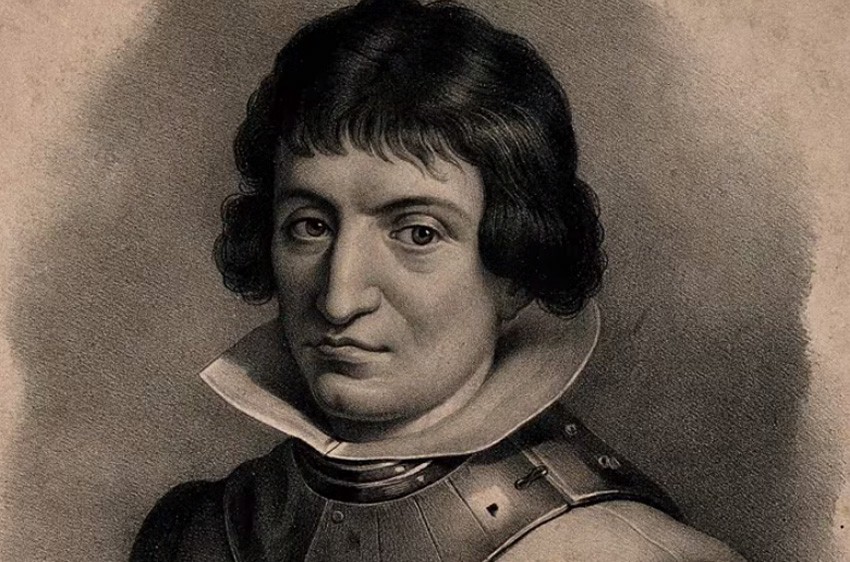

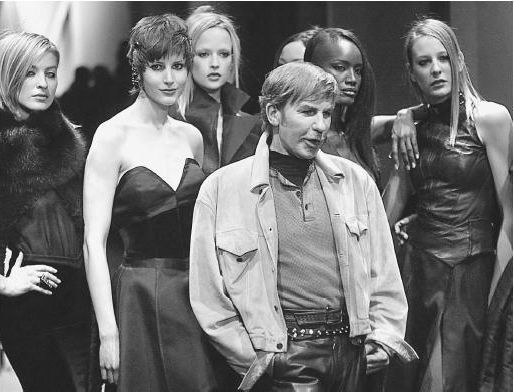
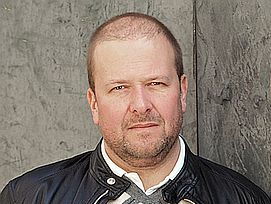
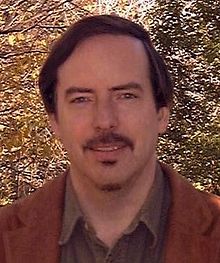

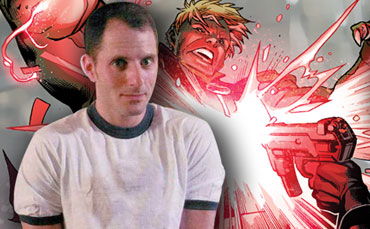
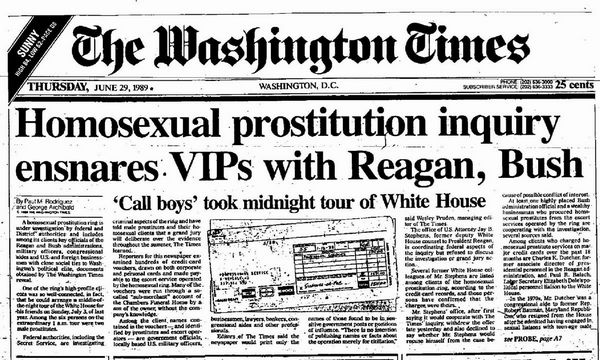

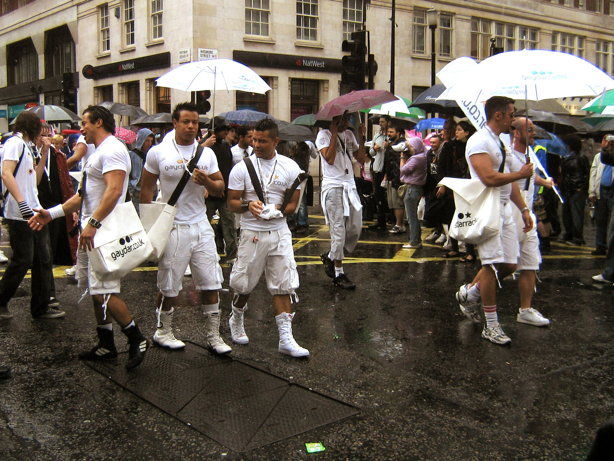 Bombs & rain don't deter London Pride marchers
Bombs & rain don't deter London Pride marchers